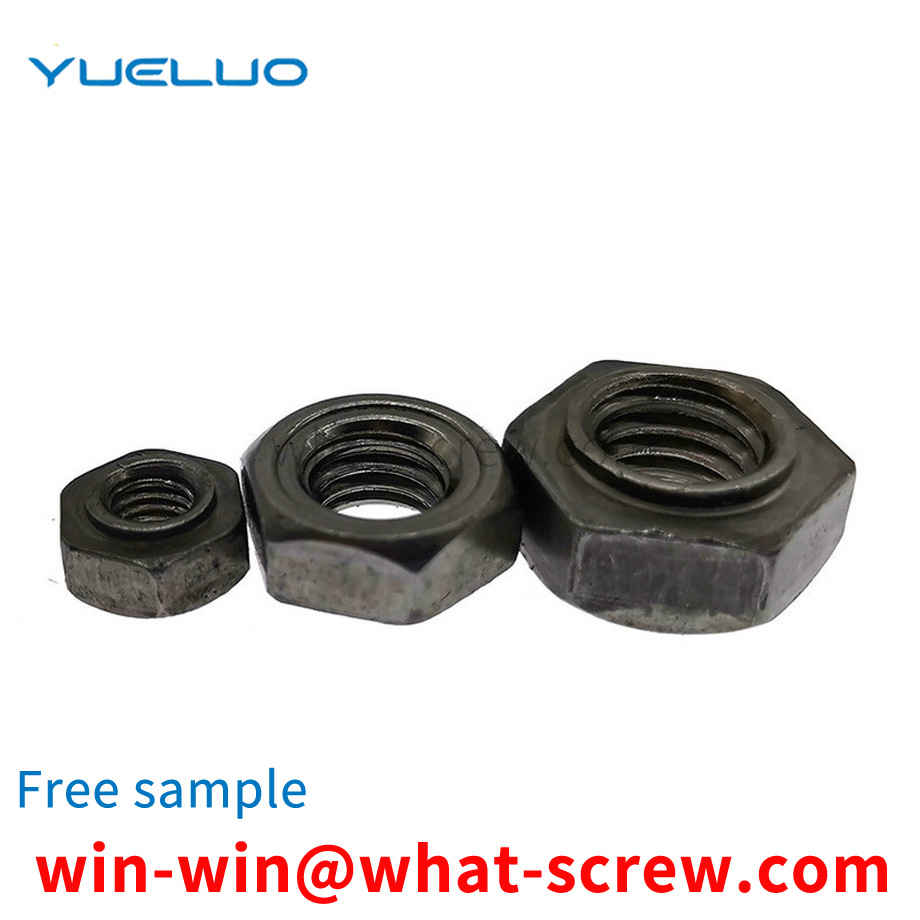Nuts are usually used in conjunction with bolts or screws to fasten other components and are a common and widely used component. In order to make the nut not easy to loosen and fall off when it is subjected to strong vibration and irregular strong toggling, the combined nut has appeared on the market.
rivet is a metal rod-shaped part with a cap at one end. During riveting, the rivet uses its own deformation or interference to connect the riveted parts. Commonly used rivets are semi-circular head, flat head, semi-hollow rivets, solid rivets, countersunk head rivets, blind rivets, hollow rivets, etc. At present, rivets are widely used in various backplane products and other stamping products. Since rivets are responsible for the functions of locking, positioning and bearing lateral force in the product, the degree of riveting and vertical have higher requirements. However, in actual production, there are often problems such as the failure of the rivet torsion to meet the requirements, the rivet being skewed by the rivet, the surface of the rivet being cut, the rivet placement being inaccurate and requiring manual repositioning, etc. Very high and very inefficient.
At present, the commonly used fastener loosening prevention methods generally include non-removable anti-loosening solutions and friction-increasing anti-loosening solutions. The non-removable anti-loosening scheme uses welding, bonding or punch point riveting to change the detachable threaded connection into a non-detachable threaded connection. In the non-removable anti-loosening scheme, the threaded fasteners cannot be reused and the operation is troublesome. It is often used in some important occasions that require high anti-loosening performance without disassembly. The anti-loosening scheme that increases the frictional force uses the method of increasing the frictional force of the bolt (screw) head and the end face of the nut to achieve the purpose of anti-loosening. The anti-loosening solution that increases friction is not limited by space and can be disassembled repeatedly, but the reliability is poor. After a certain period of work, the anti-loosening effect will be reduced due to vibration and other reasons.
The performance grade 8.8 of stainless steel bolts refers to the material's tensile strength limit of 800MPa and yield limit of 640MPa. The performance grades of stainless steel bolts, studs and studs are divided into 10 grades: from 3.6 to 12.9. The number before the decimal point represents 1/100 of the tensile strength limit of the material, and the number after the decimal point represents 10 times the ratio of the material's yield limit to the tensile strength limit. There are 7 grades of performance grades for nuts, from 4 to 12. The numbers roughly represent 1/100 of the minimum stress that the stainless steel nut is guaranteed to withstand. For unified inch threads, there are three thread grades for external threads: grades 1A, 2A and 3A, and three grades for internal threads: grades 1B, 2B and 3B, all of which are clearance fits. The higher the rating number, the tighter the fit. Classes 1, 1A and 1B, very loose tolerance classes, which are suitable for tolerance fits of internal and external threads. Grades 2, 2A and 2B are the most common thread tolerance grades specified for inch series mechanical stainless steel fasteners. Grades 3, 3A and 3B, screwed together to form the tightest fit, suitable for tight tolerance stainless steel standard parts, for safety critical designs. Metric threads, there are three thread grades for external threads: 4h, 6h and 6g, and three thread grades for internal threads: 5H, 6H, 7H. Thread fit is best combined into H/g, H/h or G/h. For bolts, stainless steel nuts and other refined fastener threads, the standard recommends 6H/6g fit. Carbon steel: The strength grade is marked by ? It consists of two separated numbers. The meaning of the number part before the ? in the marking code represents the nominal tensile strength, for example, 4 in grade 4.8 represents 1/100 of the nominal tensile strength of 400N/MM2. The meaning of the ? and the number part after the point in the marking code represents the yield-strength ratio, that is, the ratio of the nominal yield point or the nominal yield strength to the nominal tensile strength. For example, the yield point of grade 4.8 products is 320N/mm2. The strength grade mark of stainless steel products consists of two parts separated by —. The symbol before — in the sign code indicates the material. Such as: A2, A4 and other signs — indicate strength, such as: A2-70 Carbon steel: The mechanical properties of bolts can be divided into: 3.6, 4.6, 4.8, 5.6, 5.8, 6.8, 8.8, 9.8, 10.9, 12.9 in total 10 performance levels
In order to achieve the above purpose, Guangdong Yueluo Hardware Industry Co., Ltd. discloses a tamper-proof nut, which includes an upper part, a lower part, and an inner threaded hole penetrating the upper part and the lower part. The cross section of the inner threaded hole is circular, so the The lower part is an equilateral triangle cylinder, and the apex of the equilateral triangle cylinder has an arc structure, and the arc structure includes a left arc part and a right arc part with the angle bisector as the center of symmetry, and the lower part has an arc structure. A tamper-proof portion protruding from the lower surface is formed, and the tamper-proof portion is arranged at the left arc portion or the right arc portion.
We have many years of experience in the production and sales of screws, nuts, flat washers, etc. The main products are: locking screw anti-loose, non-standard rivet manufacturers, box screws, GB2673 screws and other products, we can provide you with suitable fasteners solution.



















 Service Hotline
Service Hotline




